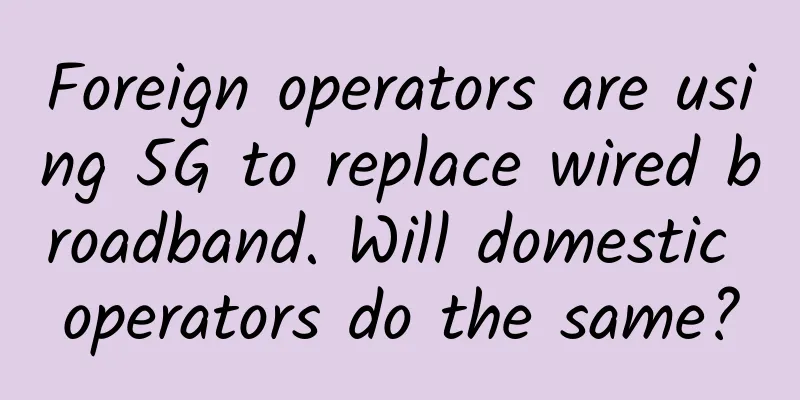How businesses can prepare for 5G

|
While people may think of 5G as a cool technology concept, don’t overlook the fact that it will have a significant impact on enterprise IT. Given the promise of lower latency, data speeds that will be 100 times faster than 4G networks, and the expected ability to handle any type of IoT device today, many businesses are incorporating 5G networks into their IT plans. In the deployment of 5G, countries around the world are facing deployment pressure to adopt 5G technology faster, while communications manufacturers hope to dominate the market. As these competitive pressures increase, corporate CIOs need to think about what they are doing to prepare for the arrival of 5G, what business cases can benefit from 5G, and whether or when 5G should be deployed. There are no clear answers to these questions because 5G itself is in a state of disruptive development. This technology cannot be adopted everywhere. Most of today's IT equipment and networks cannot support 5G. There are almost no trained IT professionals to install or support 5G, and the market development of 5G is not stable. 5G is coming. So, given the current instability of 5G technology deployments and the need to prepare for 5G, what should CIOs and IT strategic planners do now? Evaluate business 5G is an opportunity for enterprises to reimagine their business and think about what they could do in terms of business if they were not limited by bandwidth and slow data speeds. In healthcare, removing communication restrictions could mean increased ability to deploy telemedicine and remote surgery to remote locations. In manufacturing, unlocking the potential of communications technology could bring endless opportunities to manage all types of Internet of Things (IoT) devices and robotics in factories around the world. In cities, unrestricted communications could provide more ways to manage transportation networks and autonomous vehicles. However, in other business cases, some are still using 4G or even 2G technology. Discussions about current and future business directions, and the communications needed to support them, should be conducted by the CIO, other executives, enterprise technology experts, and board members. In these discussions, business opportunities and use cases should be identified, as well as the IT expertise required to support 5G. If 5G is determined to be a solution that can advance the business, especially if large-scale 5G deployments are expected, steps should be taken to estimate the 5G budget and the readiness of IT staff and 5G support resources. Assessing 5G infrastructure People can understand enterprise 5G infrastructure from three different perspectives: •5G suppliers are willing to provide 5G services to users. • Whether the internal network and other related IT infrastructure are ready to handle 5G. •The company’s IT staff is ready to support 5G. At the supplier level, service providers are under pressure to build an infrastructure that can meet 5G support tasks, including new fiber optic networks and routers. This is the conclusion of a research report by Deloitte. The United States will invest $130 billion to $150 billion in fiber optic cabling to meet the needs of 5G technology. Although many communications service providers expect to reach major milestones by 2020, security and other technical vulnerabilities may arise with the deployment of 5G. This makes it critical for IT organizations to choose 5G suppliers wisely and establish close partnerships with their 5G suppliers. A comprehensive audit of existing IT networks, hardware, and software should also be conducted to determine which enterprise networks or network components need to be upgraded or replaced with 5G technology. At the user level, smartphones and other portable devices will need to be upgraded or replaced. At the IT infrastructure level, edge computing will face new pressures from 5G, forcing switches and routers to upgrade. Finally, the 5G readiness of your IT staff should be considered. The rapid expansion of transmitted data and connected endpoints can create opportunities for security vulnerabilities. New network management challenges may also emerge as 5G and IoT are deployed. Choosing the right enterprise IT scale for 5G applications Adopting 5G brings benefits, but it also comes at a high cost. Enterprises need to spend wisely based on their needs, as not every IT system needs to adopt 5G. In planning and budgeting, CIOs should focus on systems and applications that work well at lower bandwidths. For example, a product manufacturer may want to track its containers, which are being picked up by various third-party logistics companies and delivered to stores. The goal may be to see which logistics provider's service and route is more efficient and economical. To conduct these analyses, IoT data is collected during the transportation process and then aggregated and analyzed. Conclusion While early adopters believe that 5G can immediately realize strategic and operational benefits for the enterprise, most companies are patiently waiting. Some enterprises are methodically developing clear strategic and operational plans to make 5G part of their IT plans in the next one to two years. For those companies that can be patient, 5G vulnerabilities need to be studied and addressed, making 5G deployments smoother and less risky in the future. Although some companies have not made 5G deployment plans, they cannot sit idly by. Whether through their own efforts or with the help of hardware, software and cloud computing suppliers, they will use 5G to support business development. For businesses to plan and reimagine 5G technology, the time is now. |
<<: South Korea's 5G users approach 10 million, with mixed results for the future
>>: Unleashing the power of the tactile internet through 5G networks
Recommend
Tsinghua Unigroup's H3C wins China Mobile's 2020-2022 IPS centralized procurement project with the largest share
Recently, China Mobile announced the bidding resu...
A collection of network failure and cause analysis (with solutions included)
[[265984]] In life and work, we will inevitably e...
Web3 Explained: A Chaotic Vision for the Future of Technology
Web3 is considered to be the future development t...
How advanced is the "Smart Island" with 20,000 people? Let me help you experience it first!
[51CTO.com original article] On March 21, Huawei ...
ZJI: 580 yuan/month 2×E5-2630L, 32G memory, 480G SSD, 10M bandwidth, Hong Kong Confederation data center
ZJI is a well-known hosting company in the WordPr...
Discussing the five key technologies for building 5G
It is widely believed that 5G mobile networks wil...
Another global battle for 5G has begun! What should China do?
At present, in addition to 5G, another global com...
Traditional database upgrade practices under the cloud-native evolution trend
1. Overview of Cloud Native Databases 1. Cloud co...
[Black Friday] spinservers: $270 off San Jose high-end servers, dual E5-2683 v4, 512G memory, 2*3.83T SSD, 10Gbps bandwidth
There are still a few days before Black Friday, a...
Stop saying you can’t afford data. Check out the N ways to unlock 5G packages
Hu Jianbo, chief engineer of the China Academy of...
IDC survey: Only 9% of enterprises plan to use 5G for IoT deployment
5G promises to be ten times faster than existing ...
ZgoCloud: $14/quarter-AMD Ryzen9, 1GB memory, 30G NVMe, Osaka, Japan data center
ZgoCloud domain name registration started in Apri...
The Bluetooth market will grow steadily in the future, and the Bluetooth SIG will continue to make efforts
On April 15, the Bluetooth Special Interest Group...
Diagram: Page replacement algorithm
[[398509]] This article is reprinted from the WeC...
There will be a chance in 2020: Why is it so difficult to port your number? !
Number portability is an urgent need Number porta...









